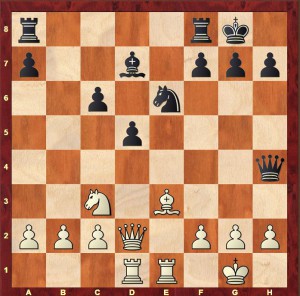Watching Mihai’s Marin analysis of Karpov’s middlegame skills on a recent Chessbase DVD has been a wonderful learning experience. Marin identified a facet of Karpov’s play that I had never noticed before: moving the same piece many times in succession. After this manoeuvre, no one knows why, but he’s better!
Marin cites many examples. This example – from my first ever chess book, the book of the Karpov-Kortchnoi 1981 World Championship Match in Merano – demonstrates Karpov’s repeated use of the knight:

The position after Kortchnoi’s 17th move (17…Qh4). Karpov had already taken the first step in his plan by playing 17.Qe2-d2, freeing e2 for the knight. Now the knight dance begins. Karpov wants to bring his knight to d3 eventually, but he takes it all around the houses first!
Karpov-Kortchnoi
World Championship Merano 1981
17.Qd2 Qh4 18.Ne2
18…Rfe8 19.b3 Re7 20.Ng3
20…Qf6 21.f3 Be8 22.Ne2
22…h6 23.Bf2 Qg6 24.Nc1
24…d4 25.Nd3
Nobody knows how Anatoly has done it: he’s moved his knight 5 times in the past 8 moves and while he’s been doing that, Black’s position has lost its coordination completely! The rest was pretty painful for Black.
25…Qf6 26.Bg3 Rd7 27.Re5 Qd8 28.Rde1 Rd5 29.Rxd5 Qxd5 30.Re5 Qd7 31.Qe1 Rc8 32.b4 Qd8 33.Ra5 Qd7 34.h3 f6 35.Rxa7 Qd5 36.Ra5 Qd7 37.Ra7 Qd5 38.Ra5 Qd7 39.Qe4 Bf7 40.Qf5 Re8 41.Kh2 Qb7 42.a3 Rd8 43.h4 h5 44.Nf2 Qd7 45.Ra6 Qe8 46.Qa5 Bg6 47.Nd3 Kh7 48.Qb6 Rc8 49.a4 Bf5 50.a5 c5 51.bxc5 Bxd3 52.cxd3 Nxc5 53.Ra7 Qg6 54.Rc7 Rxc7 55.Bxc7 Nxd3 56.Qxd4 Ne5 57.Bxe5
1–0
While listening to the DVD, it struck me that Alekhine had also played a few games in which the repeated movement of one piece had mystically led to the worsening of the opponent’s position! Let me show you 3 examples!
The dark-squared bishop
Alekhine-Rubinstein
The Hague 1921
1.d4 d5 2.Nf3 e6 3.c4 a6 4.c5 Nc6 5.Bf4
This bishop moves 4 times in the next 9 moves!
5…Nge7 6.Nc3 Ng6 7.Be3
7…b6 8.cxb6 cxb6 9.h4
“The only means of…obtaining a future for the bishop on e3” – Alekhine.
9…Bd6 10.h5 Nge7 11.h6
Black’s development doesn’t have any obvious weaknesses, but Alekhine exploits a far from obvious drawback of putting the bishop on d6 and knight on e7: the f6 square is difficult to cover!
11…g6 12.Bg5 0–0 13.Bf6
With a fantastic position for White. Alekhine makes a very instructive comment: “An extraordinary position after the 13th move of a Queen’s Gambit! During the first 13 moves, White has played his c-pawn thrice, his h-pawn thrice and his bishop 4 times, after which he has reached a position in sight of a win, if not actually a winning one. It is especially with respect to the original opening of this game that people speak of a “hyper-modern technique”, a “neo-romantic school” etc…The question is in reality much simpler. Black has given himself over to several eccentricities in the opening (3…a6, 5…Nge7, 6…Ng6) which without the reaction of his opponent would in the end have given him a good game. It is therefore as a necessity, and not with a preconceived idea, that I decided upon the advance of the h-pawn, preventing Black from securing an advantage in the centre.”
The light-squared bishop
Alekhine-Euwe
World Championship 16th Netherlands 1935
1.e4 e6 2.d4 d5 3.Nc3 Bb4 4.a3 Bxc3+ 5.bxc3 dxe4 6.Qg4 Nf6 7.Qxg7 Rg8 8.Qh6 c5 9.Ne2 Nbd7 10.Ng3 Rg6 11.Qe3 Nd5 12.Qxe4 Nxc3 13.Qd3 Nd5 14.Be2
The first development of the bishop.
14…Qf6 15.c3 cxd4 16.cxd4 N7b6
As Alekhine proudly states, “This bishop manoeuvre consisting of 4 consecutive moves forces a practically decisive weakening of Black’s pawn structure.”
17.Bh5
The first attack on the rook. The rook must retreat to g7 to cover h7
17…Rg7 18.Bf3
Threatening Nh5 forking the queen and rook. It’s a lovely idea though as Karsten Muller points out, 18.Ne4 Qe7 19.Bh6 Rg8 20.Qf3 was even stronger, when the threat of Bxf7+ followed by Nd6+ cannot be avoided without material loss.
18…Qg6
18…Rg6 19.Be4
19.Be4
19…Qf6 loses to 20.Nh5 so Black is forced to weaken himself
19…f5 20.Bf3
Even retreating occurs with gain of tempo for Alekhine! White threatens Bh5 winning the queen.
The queen
Alekhine-Wolf
Bad Pistyan 1922
1.d4 d5 2.Nf3 c5 3.c4 cxd4 4.cxd5 Nf6 5.Nxd4 a6
An unusual and risky idea. Alekhine reacts energetically.
6.e4 Nxe4 7.Qa4+
The first of 4 queen moves in the next 5 moves!
7…Bd7 8.Qb3 Nc5 9.Qe3
9…g6 10.Nf3
10.Qe5 Also looks reasonable!
10…Qc7 11.Qc3
11…Rg8 12.Be3 b6 13.Nbd2 Bg7 14.Bd4 Bxd4 15.Qxd4
With a great position for White
Wonderful play from Alekhine.




After 17…Rg7 18.Bf3 I think Black is to move in the diagram. Another famous slow Knight move of Karpov is 20. Nh3 against Kasparov (1986) http://www.chessgames.com/perl/chessgame?gid=1067228 Best wishes 🙂
Hi Carsten, thanks once again! Corrected the diagram! 20.Nh3 was indeed a stunner from Karpov! Best Wishes, Matthew